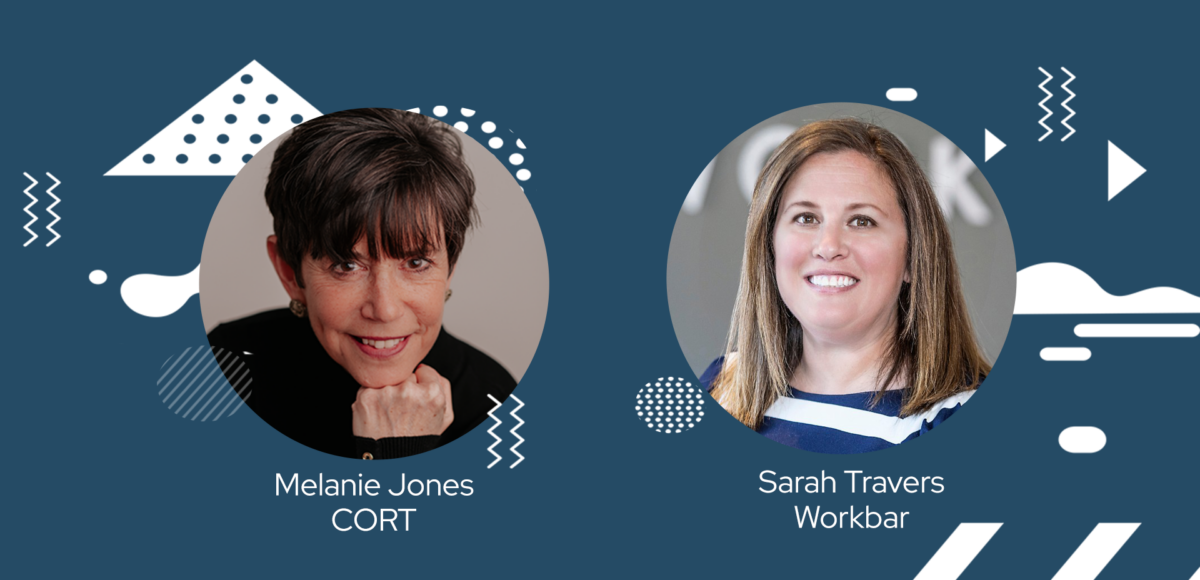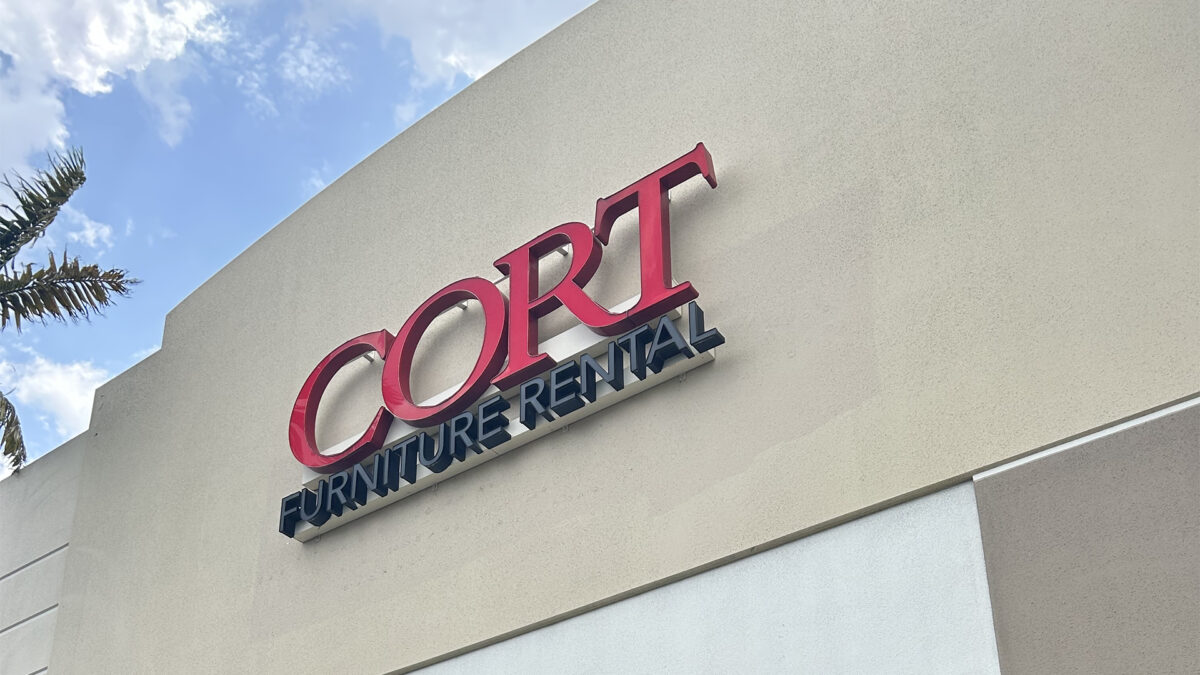Written by: Melanie Jones
In my opinion, up until now, the CORT Furniture-as-a-Service™ model hasn’t offered tremendous value to typical coworking operators. The rhythm consisted of establishing furniture standards and purchasing products to support coworking offices in a ten to fifteen-year lease. Makes sense!
However, the landscape is changing quickly. As customization, flexible environments, and even expansion of how flexible space is being sold, managed, and utilized, there’s a change in the relevance of solutions like that from CORT.
A few industry leaders embody the boldness to drive change with an eye on innovation. One of them is Sarah Travers, CEO of Workbar. I’m grateful for her time in sharing valuable insights into Workbar’s unique approach to coworking, its expansion strategy, and the value it brings to landlords and tenants.
Join us as we delve into the world of flexible offices and the future of flexible office spaces.
The Workbar Model: Reinventing Coworking
MJ: Sarah, it’s a pleasure to have you here. We met at GCUC, where you shared some fascinating details about the strategy and execution of Workbar. Seeing you share the stage with Ryan Simonetti of Convene was impressive. Both Workbar and Convene are CORT customers. Yes, I was smiling as I listened to insights from two of the best in the business. That’s why I thought it was time we communicate more about the continued expansion of flexible offices and coworking. Thanks for joining. You’ve become a bit of a celebrity!
ST: Oh, my gosh, I appreciate that. I’ve been in this industry for a long time and am passionate about every bit of it. Our work is about fostering human happiness. It’s an important job and service. If I’m a celebrity in this talented group of people, I trust it’s because of the hopeful energy I bring to the table.
MJ: Your passion shines through, and it’s contagious! Listening to you share the Workbar model at GCUC I knew I needed to capture more of your insights. Would love for you to share what makes you and the team special.
ST: Workbar has a very different model than many other service providers in our industry. We’ve reworked the traditional model quite a bit. Historically, larger operators have saturated urban markets with cookie-cutter spaces full of private offices. Workbar has a regional presence, and our members can access all our locations.
Typically, one envisions a coworking space as an office on a floor of other offices. It’s where you work, occasionally see other people, and access a shared kitchen. Maybe a “reception” area. All too often, a person goes into their company’s office in a coworking space, closes the door, and works there for the day.
Let me share a few highlights of how our model is different.
Workbar’s Regional Expansion: Creating Workbar Neighborhoods
ST: We have eleven locations in the greater Boston area. Two are downtown, and the others are strategically scattered about in the suburbs. We pioneered this trend in 2015 because we listened to our members, and that’s what they wanted.
The idea was to provide a dynamic, open coworking space closer to where people live because most of us would prefer to spend less than half a day commuting to and from the city.
We opened new locations in the suburbs and discovered a new membership base. Our strategy evolved, and expansion focused on suburban markets that fit our location requirements. We are selective and look for specific criteria before even considering a space. Essential to our members and us are things like 20 minutes from the city, right off the freeway, walkable, bike paths, significant outdoor space, and an open physical layout in the space itself.
We feature Workbar “neighborhoods” inside the spaces that allow members to be in different environments throughout the day. Visualize a library for quiet time, a cafe for socializing, team collaboration rooms, enterprise suites, podcast rooms, etc. Innovation only sometimes happens sitting in an office alone. We believe in bumping, connecting, and sparking innovation through being in close proximity to people. And we invest in lots of comfortable furniture so we appreciate the partnership with CORT. At the end of the day, it’s about wifi, an inclusive community, good coffee, and comfort!
Collaboration with Landlords: Creating Value Together
MJ: I’m also curious about your relationship with landlords and how Workbar creates value for them. Since you understand the suburban market, let’s talk about it. Dialogue is abundant about Class B buildings needing help compared to Class A downtown spots with the latest and most lavish amenities. Are you bringing value to those landlords and the suburban Class B buildings?
ST: Absolutely, yes! We consider our landlords our partners. We’re not a passive tenant in any of our buildings. We bring value in terms of standalone locations and the activation we bring to the whole area.
Think about a Class B space. If I steer a local, mobile membership base to these locations, I pull in unique foot traffic around the location every week. That provides some real data-driven value, and that type of data is easy to share with landlords considering activating their buildings. So that’s absolutely part of our conversation and a big reason why we track our member utilization and the mobility of our members from one Workbar location to another.
Synergy Suites: Transforming Vacant Spaces
MJ: Makes total sense. How about supporting landlords with vacant spaces? What’s the value for them in tapping into the Workbar ecosystem?
ST: Really interesting questions, Melanie. For example, we are working with a landlord in twelve of their assets in Boston. We took over the leasing and management of their spec suite program. We are a lead generation machine with plenty of relevant data on people and companies looking for space. We are ideally suited for this mission. The spec suites are now called Synergy Suites by Workbar.
The idea is a tenant opts for a downtown location with a short-term lease. It could be 3,000 square feet or 10,000, depending on what’s available in the portfolio. We enable the tenant to secure that space as their hub for a flexible amount of time, usually 12 to 24 months, plus their employees get our Team–share passes, giving them access to our network of spaces.
Since we have various products, we can help people sort through what they need. I love this combination because when a company moves into a Synergy Suite, they can access all the Workbar locations! There is no more one size fits all, not even close. And obviously, the landlord benefits from our sales and marketing efforts.
Customizable Spaces with Sustainable Solutions
MJ: It’s impressive how you cater to tenant needs. Does Workbar provide hospitality services in these suites?
ST: There’s no hospitality layer in the suite. We work with your team to furnish it, though! As tenants are preparing to move in we are still determining what they want in the way of design and furniture. We really lean on the expertise of the CORT team and a vast selection of workplace and soft seating to customize the space for the company and employees. We also have a lot of sustainability goals, and your subscription model is perfect for that. The last thing we want is to buy furniture and put it in a landfill!
Bridging the Gap Between Tenants and Landlords
MJ: It makes sense to me to have flexible furniture for a flexible office lease. The on-demand flexibility just makes sense.
ST: Agreed! This is still a new offering for us, and I imagine we’ll have some iterations as we continue to learn what employees and companies want, but it’s been very successful.
My opinion is that this product really bridges the gap between
modern tenants and traditional landlords.
Modern tenants demand flexible terms, and landlords are doing 12-month deals. What makes us unique is helping the tenant with the 12-month agreement, plus being part of the Workbar family!
Driving Change in the Coworking Industry
MJ: I read this piece, “Real Estate Professionals Are Adopting New Approaches For Value CoWorking Spaces” from Propmodo the other day. The topic of the changing nature of building valuation concerning flexible space has been tossed around for a long while now. Thoughts?
ST: When I demonstrate we’re able to generate $90 a square foot in revenue in a building that typically gets $30 or $35 for gross rent, that’s attractive. We have ten years of financial data I can share with a landlord. We should see change when we, the industry, can consistently serve this information to landlords, lenders, and analysts. Recently I’ve noticed landlords bringing lenders with them to visit our spaces. That’s new. Everyone is trying to get comfortable with being more innovative in deal structuring. At the end of the day, it’s about risk and who owns the risk. The Workbar model is simply less risky for landlords and their partners. Fewer walls equate to more cost-effective buildouts, and a wide variety of members equates to more diverse revenue streams.
Expanding Beyond Boston: A Bright Future
MJ: Do you see Workbar expanding beyond Boston? Nashville, close to me, would be magnificent.
ST: I do. I see that! We’re gearing up right now. The talk I gave at GCUC was about profitability and margins in our industry. What we’re doing at Workbar has taken literally the entire decade to figure out and perfect. We’re ready to take this model and replicate it in another market in North America. We wanted to be patient and wait until we had a solid playbook and history of performance before we started planning our expansion. Because our core differentiator is the regional density we build, we need to do more than just plant a flag in Chicago or Miami. We need to open five to eight locations all at once. It’s imperative to us that we offer the exact value of open reciprocity between all our locations. Exciting, but we must be prudent.
Opportunities and Challenges
MJ: Melinda Holland, President and COO of WeWork Americas, spoke at the GCUC, and I know we both loved her sharing and perspectives. During Q & A, a person asked about the rough patch WeWork is experiencing. I thought she handled it gracefully and replied, “Let me just say opportunity, opportunity, opportunity.” Do you agree with her?
ST: Melinda was fantastic! She is a remarkable individual to be able to get up on stage in front of all of her industry colleagues and handle that comment. But yes, that’s precisely how I see it!
MJ: What keeps you up at night?
ST: I think about the challenges of running a growing business. More so, I land on the opportunities and the macroeconomic changes that we’ve seen post-pandemic. Workbar is responsible for getting this model out into the rest of the universe. I agree with Melinda that it is opportunity, opportunity, opportunity time!
MJ: I can see how that would keep lots of things chilling in the back of your mind. That, and two young children. You too are remarkable and thank you for your passionate leadership in our industry!
About Sarah Travers
Sarah Travers, the visionary CEO of Workbar, has revolutionized the coworking industry with a unique regional model that prioritizes member needs and fosters collaboration.
At Workbar, Sarah has built a regional model at scale, while balancing growth and margin, to achieve self sustained profitability. The core highlights of Workbar’s model include an adaptable and reusable physical layout that scales in size and asset class, efficient operations, good locations and a quality brand with valuable IP. In 2017, Workbar was recognized as the world’s first WELL certified coworking space.
Sarah has served as a leader in the coworking industry for more than two decades, beginning her professional career in the corporate world of global provider Regus/International Workplace Group (IWG). Since being named CEO in 2018, she has centered Workbar’s future-proof business model on how people want to work today.






